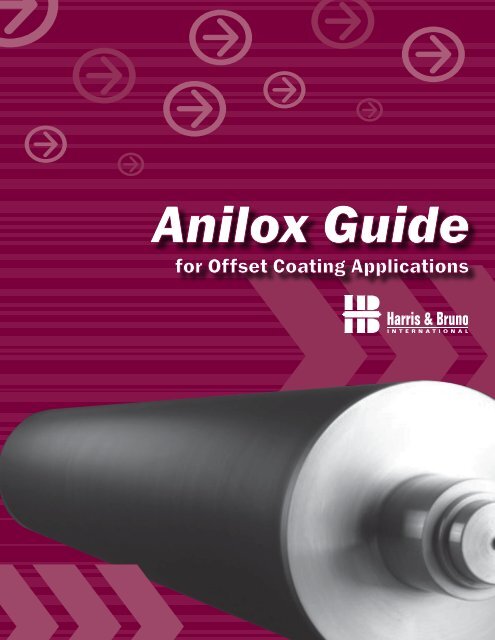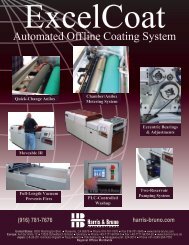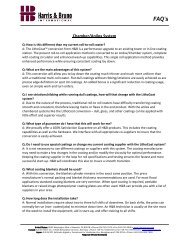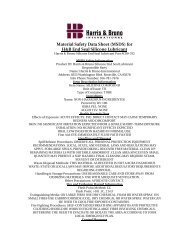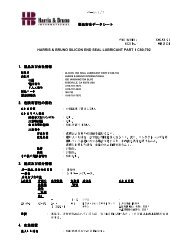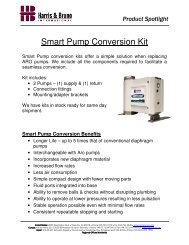You also want an ePaper? Increase the reach of your titles
YUMPU automatically turns print PDFs into web optimized ePapers that Google loves.
<strong>Table</strong> <strong>of</strong> <strong>Contents</strong><br />
H&B Anilox Rolls ............................................................................................................................1<br />
What is an Anilox Roll?..................................................................................................................2<br />
Core Construction .........................................................................................................................3<br />
Surface Geometry .........................................................................................................................4<br />
Anilox Line Screen .........................................................................................................................5<br />
Cell Volume ...................................................................................................................................6<br />
Measuring Anilox Volumes ...........................................................................................................7<br />
Banded Test Rolls .........................................................................................................................8<br />
Determining Actual Coat Weight ..................................................................................................9<br />
ASAP Diagnostic (Anilox Screening Audit Program) ................................................................. 11<br />
Anilox Roll Cleaning Procedures ................................................................................................ 13<br />
Warranty Information ................................................................................................................. 15
H&B Anilox Rolls<br />
A comprehensive guide to their construction, technology, and specifications<br />
Celebrating over 60 years in business, <strong>Harris</strong> & <strong>Bruno</strong> International is a leading supplier <strong>of</strong><br />
chamber/anilox systems for inking and coating equipment throughout the world.<br />
Similarly, we are the preferred supplier <strong>of</strong> chamber/anilox systems to the majority <strong>of</strong> the<br />
worldwide sheet-fed press OEM’s. These alliances grant us with an inclusive network <strong>of</strong><br />
press information and anilox roll drawings, allowing us to provide you with the right roll every<br />
time.<br />
Technical support is our top priority. With <strong>of</strong>fices in America, Europe and Asia and with<br />
expert engineers on site with know-how in all your printing and anilox needs, we provide<br />
superior global sales, service and support.<br />
Our value is in our industry expertise and extending the benefits <strong>of</strong> our OEM relationships<br />
which include the following:<br />
■<br />
■<br />
■<br />
■<br />
■<br />
■<br />
■<br />
High levels <strong>of</strong> roll inventory<br />
Comprehensive network <strong>of</strong> press information<br />
Quick turn-around time as we stock common cores<br />
Ability to guarantee roll specifications<br />
Cleaning service for plugged rolls<br />
Efficient logistics, transport and delivery<br />
Local representation<br />
These areas <strong>of</strong> expertise translate into value for our customers!<br />
1
What is an Anilox Roll?<br />
In coating, an anilox roll is used to provide measured amounts <strong>of</strong> coating to a coating<br />
blanket and can be thought <strong>of</strong> as a precise metering roll.<br />
An anilox roll is a hard cylinder, usually constructed <strong>of</strong> steel, carbon fiber, or an aluminum<br />
core with steel journals. This core is then plasma coated with a hard ceramic, usually<br />
chromium oxide. A high powered laser is then used to vaporize the ceramic and create<br />
tiny “cup shaped” cells in the surface <strong>of</strong> the ceramic. It is these cells that will contain and<br />
deliver the proper amount <strong>of</strong> coating to the coating blanket. A chambered doctor blade<br />
system supplies and meters coating to the anilox roll. The excess coating is metered or<br />
“doctored” from the surface <strong>of</strong> the roll leaving coating only in the cells <strong>of</strong> the anilox roll. The<br />
coating in the cells is then deposited onto the surface <strong>of</strong> the coating blanket.<br />
Anilox Roll<br />
Blanket/Plate Cylinder<br />
Anilox Roll &<br />
Chambered Doctor<br />
Blade System<br />
Sheet<br />
2<br />
Chambered Doctor<br />
Blade Assembly<br />
Coating<br />
Supply Consistent &<br />
Even Coating to the<br />
Sheet
Anilox rolls are <strong>of</strong>ten specified by their “line screen”, or, the number <strong>of</strong> cells per linear inch<br />
and the volume <strong>of</strong> these cells. Anilox rolls are designed to be removed from the coater<br />
and exchanged with rolls <strong>of</strong> varying line screen and volumes depending on the coating<br />
requirements.<br />
Since most coaters do not have an overhead hoist, it is preferable to manufacture the roll<br />
core from lighter weight materials such as carbon fiber or aluminum for ease <strong>of</strong> handling<br />
and to minimize the chance <strong>of</strong> damage when changing rolls out. Although the ceramic<br />
surface is extremely durable in terms <strong>of</strong> wear, it is very brittle. Extreme caution must be<br />
taken when handling anilox rolls as a single bump against a hard surface or sharp corner<br />
can destroy the delicate cell structure on the surface and render a roller completely useless.<br />
Core Construction<br />
The <strong>Harris</strong> & <strong>Bruno</strong> facility utilizes the latest technology in machinery and test equipment.<br />
In-house machining <strong>of</strong> cores allows for better process control and improved lead times.<br />
HIGHEST<br />
LOWEST<br />
CARBON FIBER<br />
ALUMINUM<br />
COST<br />
STEEL<br />
BASED ON AVERAGE 40” ANILOX ROLL<br />
(6” DIAMETER)<br />
PRESS<br />
MANUFACTURER<br />
REQUIRED<br />
STRENGTH<br />
CARBON FIBER<br />
BASED ON AVERAGE 40” ANILOX ROLL<br />
(6” DIAMETER)<br />
3<br />
ALUMINUM<br />
STEEL<br />
STRENGTH<br />
CARBON<br />
FIBER<br />
ALUMINUM<br />
WEIGHT<br />
STEEL<br />
BASED ON AVERAGE 40” ANILOX ROLL<br />
(6” DIAMETER)
Anilox Engraving Terminology<br />
Screen count is the number <strong>of</strong><br />
cells per linear inch (lpi) or l/cm<br />
Screen count is measured at<br />
the angle <strong>of</strong> the engraving<br />
Screen counts from 50 lpi to<br />
1200 lpi are available<br />
Anilox cells can have varying<br />
volumes from roll to roll<br />
which are measured as<br />
billion cubic microns (BCM)<br />
Surface Geometry<br />
Anilox cell angles are predominately 60° hex pattern and the tri-helical patterns.<br />
60° hex patterns are recommended for most coating applications for the following reasons:<br />
60 Hex<br />
4<br />
2.5 BCM<br />
Tri-Helical<br />
5.0 BCM
■<br />
■<br />
■<br />
■<br />
■<br />
Cells can be positioned tightly together, allowing for up to 15% more cells in a given<br />
area.<br />
A more uniform cell wall surface is created allowing for better doctor blade<br />
performance and higher printing/coating quality.<br />
The straight side <strong>of</strong> a cell wall is not positioned horizontal thereby avoiding<br />
channeling.<br />
The hex pattern is easier to reproduce and therefore customers will notice<br />
consistency from roll to roll.<br />
Tri-helical engravings are a continuous “V” shaped cell that spirals around the axis <strong>of</strong><br />
the roll, similar to a screw thread. These engravings are typically at a 45 or 60 degree<br />
angle. Unlike hex shaped cells, these engravings do not have individual cup shaped<br />
cells. This open cell configuration is especially effective with smooth release <strong>of</strong> more<br />
viscous materials such as UV coatings and adhesives.<br />
Anilox Line Screen<br />
Line screen indicates the number <strong>of</strong> cells per linear inch or linear cm, on an anilox roll, and<br />
is a major component when specifying an anilox roll. Typically line screens increase as cell<br />
volumes decrease.<br />
Calculating the Number <strong>of</strong> Cells per Square Inch<br />
There are two calculations for determining the number <strong>of</strong> cells per square inch <strong>of</strong> an anilox<br />
roll. One calculation is specifically for 45° cell patterns and the other accounts for both, 60°<br />
or 30° anilox configurations.<br />
45° Cell Patterns:<br />
Line Screen X Line Screen = # <strong>of</strong> Cells per Square Inch<br />
Example: For a 500 Line Screen, 45° anilox roll: 500 line screen X 500 line screen =<br />
250,000 cells per sq. inch<br />
5
60° and 30° Cell Patterns:<br />
(Line Screen X Line Screen) X 1.15 = # <strong>of</strong> Cells per Square Inch<br />
Example: For a 500 Line Screen 60° or 30° anilox roll: (500 line screen X 500 line<br />
screen) X 1.15= 287,500 cells per sq. inch<br />
Cell Volume<br />
Anilox Cell Volume<br />
Cell volume is measured in Billion Cubic Microns<br />
(BCM) per square inch<br />
Cell volume determines coat weight<br />
2.5 BCM<br />
The amount <strong>of</strong> coating that is transferred from a cell depends upon the carrying capacity <strong>of</strong><br />
the cell, or the cell’s volume. Volume must be accurately measured and maintained. Anilox<br />
volumes are measured in BCMs (Billions <strong>of</strong> Cubic Microns) per square inch. For example,<br />
a typical engraving would be described as 200lpi /9.0bcm 60 degree hex. It is imperative<br />
that the volumes be checked on a periodic basis through <strong>Harris</strong> & <strong>Bruno</strong>’s ASAP Diagnostic<br />
program.<br />
Thinner films <strong>of</strong> coating are easier to manage, lay down smoother, are easier to dry, and<br />
minimize overall coating usage. The goal is to lay down the thinnest film <strong>of</strong> coating that will<br />
give the required physical and optical results.<br />
Below is a guide with approximate line screens and volumes for the most common coating<br />
applications.<br />
6<br />
5.0 BCM
Application<br />
Most Aqueous<br />
coating<br />
applications using<br />
paper<br />
S<strong>of</strong>t Touch<br />
Aqueous Coating<br />
Most UV<br />
application<br />
Appropriate Anilox<br />
Line Screen (Lines<br />
Per Inch)<br />
200-220 LPI<br />
180-200 LPI<br />
160-200 LPI<br />
7<br />
Appropriate<br />
Anilox Volume<br />
/ Screen Type<br />
8-8.5 BCM /<br />
60° Hex<br />
10-10.5 BCM /<br />
60° Hex<br />
10-14 BCM /<br />
60° Hex or Tri<br />
H&B has the ability to provide consulting services for specialty coatings such as, metallics,<br />
pearls, grits, blister, raised UV, etc.<br />
Measuring Anilox Volumes<br />
Anilox volumes are measured in BCMs (Billions <strong>of</strong> Cubic Microns). Keep in mind that we are<br />
dealing with very small measurements and that every micron is critical. How big is a micron?<br />
A human hair is approximately 70 microns in diameter.<br />
At H&B we measure our rolls using white light interferometry. This technology allows us<br />
to gather the surface features <strong>of</strong> the cells while moving down into the cells in a vertical<br />
path. This information is fed back to computer s<strong>of</strong>tware whereby we are able to generate a<br />
surface map and the internal shape <strong>of</strong> the cells.<br />
This technology can be employed using our ASAP diagnostic program whereby we can take<br />
an impression <strong>of</strong> your rolls at your facility and then evaluate them in our lab using our white<br />
light interferometry system.
Banded Test Rolls<br />
10” 10” 10” 10”<br />
6 BCM<br />
300 LPI<br />
60 Hex<br />
Typical Banded Roll<br />
8 BCM<br />
220 LPI<br />
60 Hex<br />
40”<br />
8<br />
10 BCM<br />
200 LPI<br />
60 Hex<br />
12 BCM<br />
180 LPI<br />
60 Hex<br />
A banded roll contains actual bands <strong>of</strong> different line screen and volume combinations.<br />
A banded roll test helps determine the correct line screen and volume combination for<br />
evaluating the desired coat weight. The same printed image is repeated across the sheet to<br />
correlate with the bands in the anilox roll.<br />
With coating application and technical expertise on staff, H&B provides customers with<br />
accurate engraving specifications for their applications. We also provide in plant visits,<br />
working directly with the customer to test and run various coatings and applications,<br />
<strong>of</strong>fering the technical expertise you require to keep your operations running efficiently<br />
and with superior quality. Our experts will provide recommendations from the coating to<br />
the delivery <strong>of</strong> that coating and which roll is best suited for your end result. As the leading<br />
supplier <strong>of</strong> chamber/anilox systems for inking and coating equipment, H&B supplies the<br />
hardware and the support services customers require in today’s marketplace.<br />
We are so sure <strong>of</strong> our service, that all rolls we specify will be guaranteed to meet the<br />
customer specifications or the roll will be re-engraved.
Determining Actual Coat Weight<br />
The most accurate way to determine precisely how much coating is being deposited onto<br />
the sheet is to do an actual coat weight test. This procedure covers the steps necessary to<br />
perform an accurate coating film weight test on a sheetfed press. A wet film weight <strong>of</strong> 0.8-<br />
1.2 Ibs per thousand square feet <strong>of</strong> stock is recommended for most aqueous coatings.<br />
Materials:<br />
■<br />
■<br />
■<br />
■<br />
■<br />
■<br />
■<br />
Blank stock<br />
Aluminum foil<br />
Scotch tape<br />
Razor blade<br />
Ruler<br />
Steps<br />
Gram scale with accuracy to at least 3 decimal places<br />
Calculator<br />
1. Obtain a piece <strong>of</strong> aluminum foil that is at least 12” x 16”. Fold the piece <strong>of</strong> aluminum foil<br />
in half.<br />
2. On a blank sheet <strong>of</strong> stock that is being used for the printed work, securely fasten the<br />
folded aluminum foil to the stock using the scotch tape. Be sure the foil and the tape are as<br />
flat and smooth as possible. It is also important to be sure the foil is fastened to an area <strong>of</strong><br />
the stock that will be completely coated.<br />
3. Multiple pieces <strong>of</strong> foil may be fastened to the same sheet <strong>of</strong> stock. If the size <strong>of</strong> the stock<br />
allows, repeat steps 1 & 2, each time placing the foil in a different area to be measured.<br />
Example: a) gripper operator side b) operator side tail c) gripper guide side d) guide side tail.<br />
Measuring different areas tests for coating uniformity across the sheet.<br />
4. Place the stock with the foil in the feeder about 25-30 sheets down in the pile.<br />
9
5. Lift the impression <strong>of</strong>f all <strong>of</strong> the inking units.<br />
6. Start the press and run the stock through until the foiled sheet appears in the delivery.<br />
7. Remove the foiled sheet.<br />
8. Using the ruler and razor blade cut a 4” x 6” rectangle out <strong>of</strong> the foil. Be sure to cut<br />
through both layers <strong>of</strong> foil. Separate the layers and keep a record <strong>of</strong> which sheet contains<br />
the coating. The top layer is coated and the bottom layer is uncoated.<br />
9. Place the uncoated layer on the gram scale and zero the weight <strong>of</strong> the foil. (Be sure the<br />
gram scale is accurate to at least 3 decimal places.)<br />
10. Remove the uncoated layer and place the coated layer onto the scale. Record the weight<br />
<strong>of</strong> the coated foil. This weight is the net weight <strong>of</strong> the coating in grams.<br />
Wet Pounds per Thousand Square Feet<br />
1. Divide the net weight <strong>of</strong> the coating by the square inches <strong>of</strong> the foil to obtain grams per<br />
square inch.<br />
Example: A 4x6” piece <strong>of</strong> foil is 24 square inches.<br />
The net coating wet is .025 grams.<br />
.025 divided by 24 = .00104167 grams per square inch.<br />
2. Multiply grams per square inch by 144 to obtain the gram weight per square foot.<br />
3. Divide grams per square foot by 454 to obtain pounds per square foot.<br />
Example: .150 divided by 454 = .0003304 pounds per square foot.<br />
4. Multiply pounds per square foot by 1 000 to obtain dry pounds per 1 000 square feet.<br />
Example: .0003304 x 1000 = .3304 dry pounds per 1000 square feet.<br />
5. Multiply dry pounds per 1000 square feet by 2.5 to obtain wet pounds per 1000 square<br />
feet. The factor <strong>of</strong> 2.5 is based on aqueous coating solids <strong>of</strong> 40%.<br />
Example: .3304 x 2.5 = .826 wet pounds per 1000 square feet.<br />
10
ASAP Diagnostic<br />
(Anilox Screening Audit Program)<br />
<strong>Harris</strong> & <strong>Bruno</strong> International <strong>of</strong>fers an anilox inspection program called ASAP Diagnostic<br />
(Anilox Screening Audit Program). ASAP is a simple, self test kit that’s easily performed while<br />
the roll is in or out <strong>of</strong> the press.<br />
The test is then mailed to <strong>Harris</strong> & <strong>Bruno</strong> International for a complete, free diagnostic<br />
roll report. An in-depth analysis on the overall condition and cleanliness <strong>of</strong> the roll with<br />
recommendations will be provided to the customer. Recommendations may include cell<br />
cleaning, laser re-engraving and/or a replacement roll.<br />
Request an ASAP Diagnostic kit from your local <strong>Harris</strong> & <strong>Bruno</strong> service or sales<br />
representative, or call corporate headquarters at (916) 781-7676 and a kit will be promptly<br />
mailed to you. Be sure to request multiple kits if you’d like to test more than one roll.<br />
The following page contains a sample <strong>of</strong> the free ASAP Diagnostic report that will be<br />
provided.<br />
11
Anilox Roll Cleaning Procedures<br />
Anilox rolls are high quality precision instruments that must be transported, handled, used,<br />
cleaned and maintained with extreme care. It’s equally critical that your anilox roll be<br />
cleaned on a regular basis to keep your print and coating quality at its best. Please follow<br />
our recommended care guidelines below and review the summary <strong>of</strong> services we <strong>of</strong>fer to<br />
help care and maintain your roll:<br />
Self Cleaning - How to Clean Your Roll<br />
Materials Required:<br />
■<br />
■<br />
■<br />
■<br />
■<br />
■<br />
<strong>Harris</strong> & <strong>Bruno</strong>’s “Cell Solution”<br />
Anilox roll cleaning brush with stainless steel bristles (available from <strong>Harris</strong> & <strong>Bruno</strong>)<br />
Chemical resistant gloves to protect your hands from injury and chemicals<br />
Safety glasses<br />
Clean facility water (water based coating only)<br />
Lint-free cloth<br />
Warning: Do not use a highly acidic or caustic cleaner on the anilox roll. An acceptable pH<br />
range for cleaning and using anilox rolls is 5.5 to 10.5. Be safe and use the <strong>Harris</strong> & <strong>Bruno</strong><br />
Cell Solution.<br />
<strong>Harris</strong> and <strong>Bruno</strong> recommends performing the following maintenance regularly (weekly or as<br />
needed) in order to keep the anilox roll clean:<br />
1. Start at either end <strong>of</strong> the roll by applying the <strong>Harris</strong> & <strong>Bruno</strong> Cell Solution onto the anilox<br />
roll surface. (A cell solution sample has been included in your anilox roll crate)<br />
2. Using the anilox roll cleaning brush, provided by <strong>Harris</strong> & <strong>Bruno</strong>, begin lightly scrubbing in<br />
a circular motion while applying light pressure and rotating the roll.<br />
3. Repeat the procedure until the entire roll has been completely scrubbed.<br />
13
4. Gently wipe the anilox roll thoroughly with water or 99% isopropyl alcohol. Repeat<br />
procedure on any unclean area.<br />
5. Cleanliness <strong>of</strong> the roll can be verified by using <strong>Harris</strong> & <strong>Bruno</strong>’s ASAP Diagnostic program<br />
as described in this guide.<br />
6. For difficult situations where regular cleaning is not producing the necessary results,<br />
please see below and contact <strong>Harris</strong> & <strong>Bruno</strong> to learn more about our pr<strong>of</strong>essional roll<br />
cleaning service.<br />
Pr<strong>of</strong>essional Roll Cleaning Service<br />
If your roll becomes plugged and you can’t clean it yourself, send it to us for pr<strong>of</strong>essional<br />
cleaning. If we find the roll damaged or plugged beyond what a pr<strong>of</strong>essional cleaning can<br />
correct, we can easily re-engrave the roll internally and will credit 50% <strong>of</strong> the cleaning cost<br />
towards a re-engrave. In most cases, worn or plugged rolls can be stripped and re-engraved<br />
using the original core material, saving the customer the cost <strong>of</strong> buying a new roll.<br />
Rolls will be cleaned using an enclosed anilox roll cleaning system which uses specially<br />
designed plastic pellets to gently remove dried inks and coatings. Fine polymer beads are<br />
applied under air pressure to remove the dried matter from the anilox engraving, restoring<br />
cells to their original volume. This media is non-abrasive and will not damage the delicate<br />
cell walls. This cleaning process thoroughly cleans rolls, repeatedly, without damage to the<br />
cells.<br />
ASAP Diagnostic<br />
(Anilox Screening and Audit Program)<br />
If you are unsure if your roll is plugged or not and want to test your roll on-site or in the<br />
press, simply call and we will send you our free ASAP Diagnostic kit. Once the test has<br />
been performed, mail the test back to <strong>Harris</strong> & <strong>Bruno</strong> for a complete, free diagnostic<br />
roll report. An in-depth analysis on the overall condition and cleanliness <strong>of</strong> the roll with<br />
recommendations will be provided. Recommendations may include laser re-engraving,<br />
pr<strong>of</strong>essional cell cleaning and/or a replacement roll. For more information, please review<br />
the ASAP Diagnostic program highlighted in this guide, or call <strong>Harris</strong> & <strong>Bruno</strong> International at<br />
916-781-7676.<br />
14
Warranty Information<br />
All <strong>Harris</strong> & <strong>Bruno</strong> products come standard with a 100% satisfaction guarantee. If you are<br />
not completely satisfied with this product, notify us in writing within 90 days after receipt,<br />
and you may either work together with our staff to meet your expectations or return the<br />
equipment for a complete refund.<br />
What is Covered?<br />
■<br />
■<br />
■<br />
The anilox roll has a warranty <strong>of</strong> one year from date <strong>of</strong> receipt.<br />
The anilox roll cell structure is guaranteed to be free <strong>of</strong> defects and to be within 5% <strong>of</strong><br />
the ordered volume.<br />
All journals and dimensional tolerances are to be within the original press OEM<br />
specifications.<br />
What is Not Covered?<br />
■<br />
■<br />
The surface <strong>of</strong> the anilox roll is a very hard and brittle coating <strong>of</strong> chromium oxide. Any<br />
chipping, dents or surface imperfections as a result <strong>of</strong> poor handling are not covered.<br />
Make sure to use the H&B supplied roll cover when taking the anilox roll in and out <strong>of</strong><br />
your press.<br />
The chromium oxide bond properties may be compromised if a pH cleaner over 10.5<br />
is used. Please use the recommended H&B Cell Solution cleaner, which is in the<br />
proper pH range.<br />
For more information regarding <strong>Harris</strong> & <strong>Bruno</strong> International products or services, please<br />
visit our website at www.harris-bruno.com or call our <strong>of</strong>fices at (916) 781-7676.<br />
15
USA: 8555 Washington Blvd .• Roseville, CA 95678 Ph: 916-781-7676 • Fax: 916-781-3645<br />
www.harris-bruno.com • Europe: Auf der Höhe 15 • D-73529 Schwäbisch Gmünd • Germany<br />
Ph: +49-7171-94704-0 • Fax: +49-7171-94704-20 • Japan: 2-8-26-201 Ushikubo Higashi,<br />
Tsuzuki-ward, Yokohama-city, Kanagawa-pref. 224-0014 Japan


